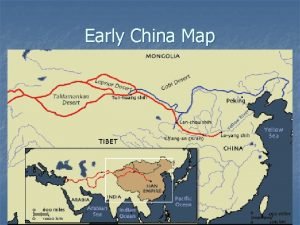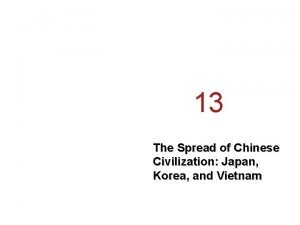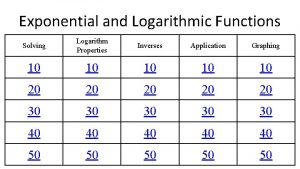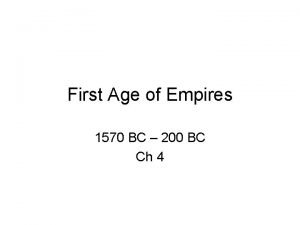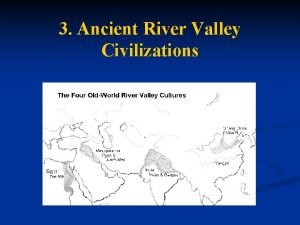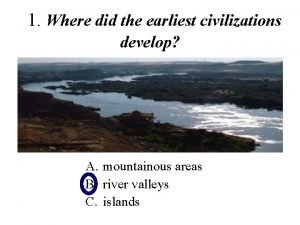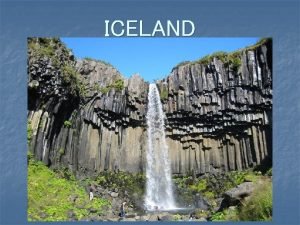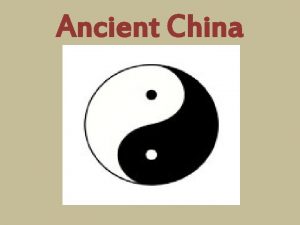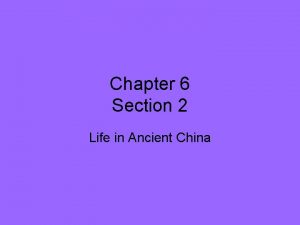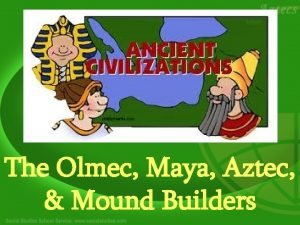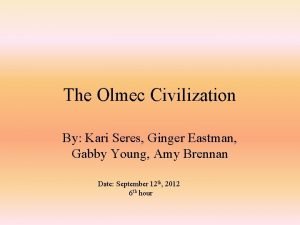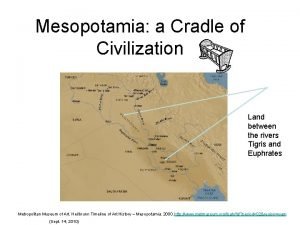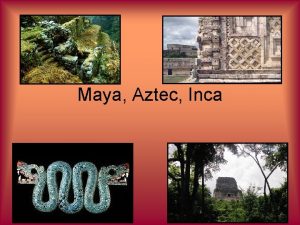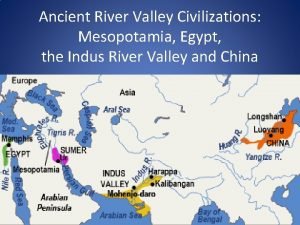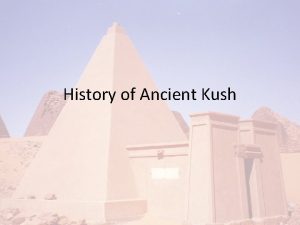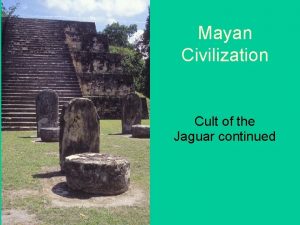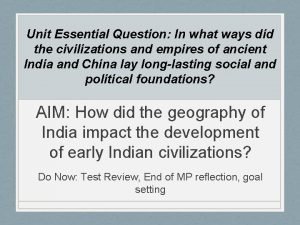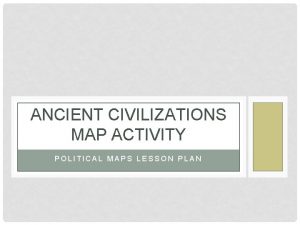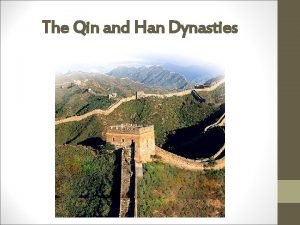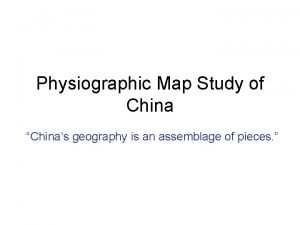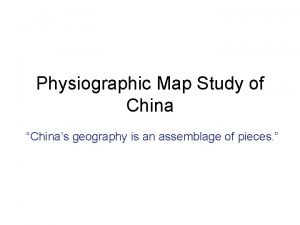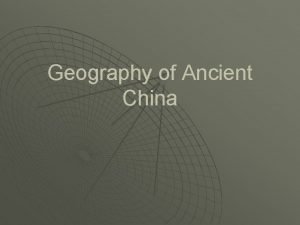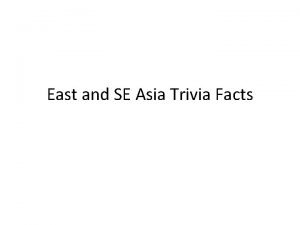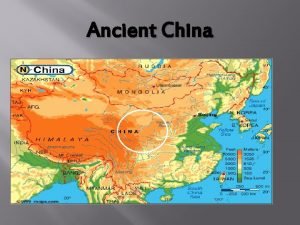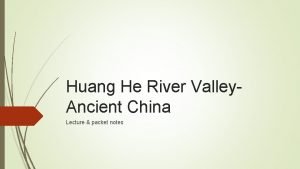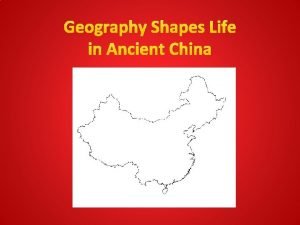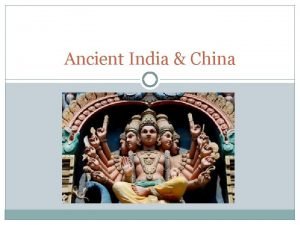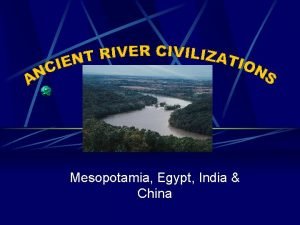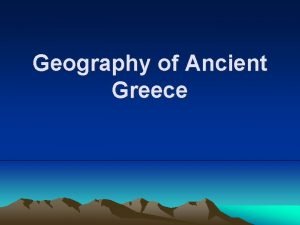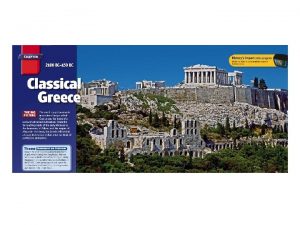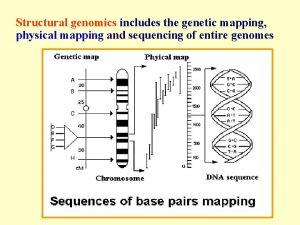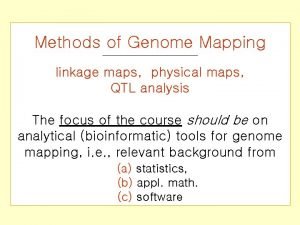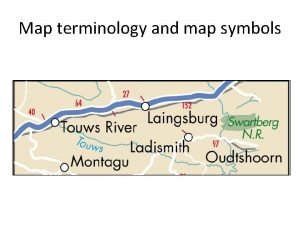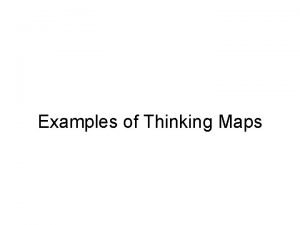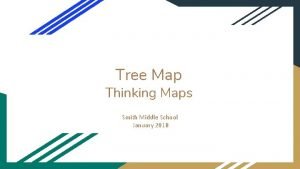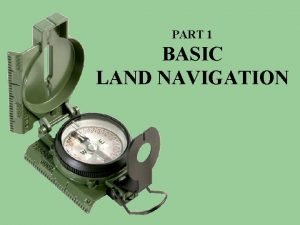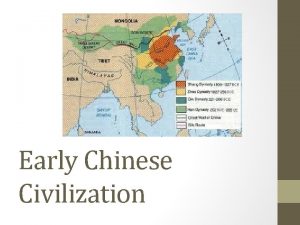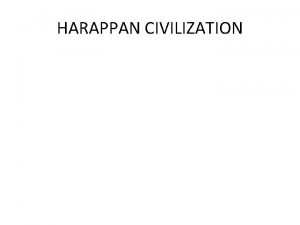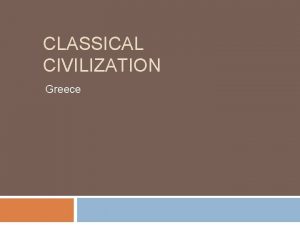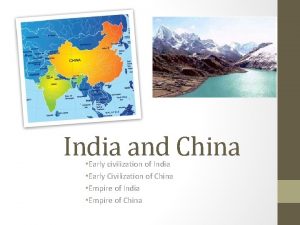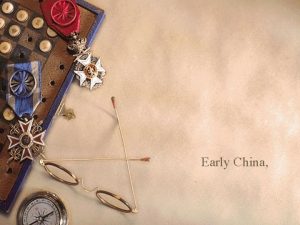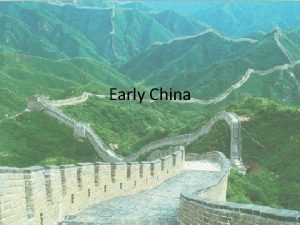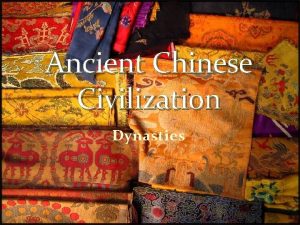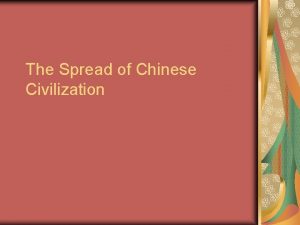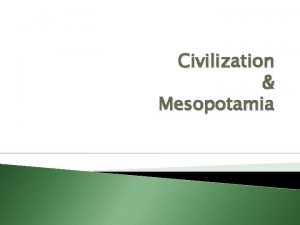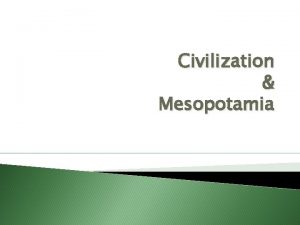Early China Map Chinese Civilization n n 1570


















































- Slides: 50

Early China Map

Chinese Civilization n n 1570 – 1045 BCE – Shang Dynasty Shang kings were political and religious heads of society Writing system of the Shang Dynasty is the ancestor of modern Chinese 1045 – 256 BCE – Zhou Dynasty The Zhou kings sacrificed to their ancestors (ancestor worship), also sacrificed to Heaven (Tian) The Mandate of Heaven (Tian Ming): (A) Close relationship between Heaven, king (B) King called the Son of Heaven (C) Heaven gives king mandate to rule, in best interest of subjects (D) Last Shang king decadent, cruel to subjects so he lost the Mandate of Heaven and the Zhou deserved to replace them

Chinese Civilization Early Literature n n Shu jing (Book of History) is the earliest transmitted text - it praises first three Zhou rulers The Shi jing (Book of Poetry) consisted of 305 poems include odes celebrating exploits of early Zhou rulers and Hymns for sacrificial ceremonies, folk songs n Folk songs - are about ordinary people in everyday situations

Chinese Civilization n n n n 770 – 403 BCE – Golden Age of Chinese philosophy 604 BCE – Life of Laozi 551 – 479 BCE – Life of Confucius 221 – 206 BCE – Qin Dynasty, first unification of China 221 BCE – Great Wall of China built 210 BCE – Terra cotta warriors placed in Lintong’s tomb 206 BCE - the Han dynasty unifies China again and develops bureaucracy 200 BCE - Mao-tun unites the Turkic-speaking Huns (Xiongnu, Hsiung-nu) in Central Asia around Lake Bajkal and southeastern Mongolia

Chinese Civilization n n n 176 BCE - the Huns attack eastern China 121 BCE - China defeats the Huns 106 BCE - the Silk Road is inaugurated (a treaty between Chinese emperor Wu-Ti/Wu Di and Parthian king Mithridates II) 2 CE - the Han empire has 57 million people, the most populous country in the world 6 CE - Buddhism is introduced in China 105 CE - Cai Lun/Tsai Luns invents paper 190 CE - the Chinese invent the abacus

Chinese Civilization n n n 520 CE – Zen Buddhism develops 618 – 907 CE – Tang Dynasty 650 CE – Acupuncture is invented and spreads 1024 CE – First paper money created 1041 CE – Bi Sheng invents the printing press 1234 CE - Mongols led by Ogodai Khagan conquer northern China

Chinese Religions n n n China’s main philosophies/religions include: Buddhism Confucianism Taoism Yin and Yang Legalism

Chinese Art n n n Fang Ding 12 th century BCE Houjiazhang , China Shang Dynasty was famous for its bronze work This was used to store food and wine for ceremonies Animal motifs are central

Chinese Art n n Bronze Bells 433 BCE Wuhan, China Zhou Dynasty – each bell is capable of producing 2 distinct notes / Bronze casts

Chinese Art n n n Terra Cotta Warriors 210 BCE Lintong, China Buried in the tomb of the 1 st Qin emperor Qin Shi Huang Di Life sized figures were meant to serve and protect the emperor in the afterlife

Army of Emperor Shi Huangdi Shaanxi Province, China 210 B. C. E. painted terracotta

Army of Emperor Shi Huangdi Shaanxi Province, China 210 B. C. E. painted terracotta

Army of Emperor Shi Huangdi Shaanxi Province, China 210 B. C. E. painted terracotta

Chinese Art n n n Colossal Buddha 460 – 470 CE Yungang, China Buddhism spread in importance as internal strife increased in China during the 5 th – 6 th centuries Carved directly into the rock – heavily influenced by Indian art

Vairocana Buddha, Longmen Caves Luoyang, China ca. 670 -680 C. E. central figure 50 feet high

Vairocana Buddha, Longmen Caves Luoyang, China ca. 670 -680 C. E. 50 feet high

Chinese. Great Wild Goose Pagoda at Ci’en Temple, Xi’an, Shanxi, China. Tang dynasty, first erected ca. 645 CE.

Horse 8 th to 9 th century C. E. 20 in. high glazed earthenware

Chinese Art n n n The Poet Li Bai Walking and Chanting a Poem 1200 CE China Artist: Liang Kai Song Dynastic period Contrast of blurred lines of robe with details of face – reflects a Zen style of art

Chinese Art n n n Early Spring 1072 CE Taipei, Taiwan Artist: Guo Xi Song Dynasty Era 3 forms of perspective are found in this work: (1) height – up the mountain; (2) depth – down into the valleys; and (3) level – looking across the marshes

Chinese Art n n n n Celadon Ware 1127 – 1279 CE China Song Dynasty Era Celadon ware is known by its green color and blends the parts of vases The most highly regarded Chinese ceramics are from the Song Dynasty Song ceramic ware aims at being simplistic and elegant

Chinese Art n n n n Searching for the Past 1641 – 1704 CE China Artist: Shitao (aka Daoji) Qing Dynasty Era Ink on paper Use of wet brush technique allows for the ink and colors to merge and blur

Chinese Art n n n Forbidden City Begun 1402 Beijing, China Foreigners were forbidden to enter into the imperial complex Built on a grid pattern all buildings facing south

Forbidden City

Foguang Si Pagoda Yingxian, China 1056 C. E.

Foguang Si Pagoda Yingxian, China 1056 C. E.

Chinese Erotic Art

Japan Map

Japanese Civilization n n 10, 000 - 300 BCE - Prehistoric period of tribal/clan organization Stone Age hunters and gatherers who make jomon (rope -patterned) pottery inhabit Japan 660 BCE - Mythological Jimmu (Divine Warrior), descendant of sun goddess Amaterasu Omikami, founds first Japanese empire 300 BCE – 300 CE – Yayoi Perido - Rice cultivation, metalworking, and the potter's wheel are introduced from China and Korea 100 -300 CE - Local clans form small political units

Japanese Religion - Shintoism n n n n The most significant influences that arrived from Korea and China in Japan were in the realm of religion Most important of all was the arrival of Buddhism However the Japanese did have an indigenous religion, called Shinto started out as a nature worship religion and evolved into a state religion of patriotic appreciation to the Japanese land itself Shintoism also would include animism and ancestor worship Shinto rituals could be performed in homes as well as in temples – allowing it to become a more personal religion To an extent, the development of Shintoism was a reaction against foreign influence, especially that of China.

Japanese Religion - Shintoism n n n In the 7 th-8 th centuries, the Japanese wrote down their native myths and legends in a collection called Kojiki (Chronicles of Ancient Events) In it are the creation myths and foundation of the Shinto religion Shinto gods are called kami Izanagi and Izanami were the first gods from whom all other gods descended The most important of whom is Ameterasu, the sun goddess, who is considered the ancestor of all Japanese emperors

Japanese Art n n n Jomon Earthenware Pot 2000 BCE Japan Use of geometric patterns to create various impressions Called Jomon (rope) because the patterns are rope-like in appearance

Japanese Art n n n Haniwa Figures 5 th – 4 th centuries BCE Japan These figures were placed on the tops of graves Each one representing the deceased below or his/her interests

Japanese Art n n n Horyu-ji Kondo 670 CE Nara, Japan Oldest wooden temple in Japanese favored lateral over linear movement and building are lined up left to right rather than one in front of the other

Horyu-ji kondo Nara, Japan ca. 680 C. E.

Horyu-ji

Fujiwara Japan. Todaiji Temple, Nara, Japan. Built 752, reconstructed, 1709.

Phoenix Hall Byodoin, Uji, Japan 1053 C. E.

Japanese Art n n n n Shaka Triad 623 CE Nara, Japan Artist: Tori Busshi Asuka Period The Buddha is flanked by 2 bodhisattvas sitting on a throne Buddha’s name in Japan is Shakyamuni

Japanese Art n n n Tale of the Genji –Azumaya Chapter 12 th century CE Nagoya, Japan Heian Hand scroll Emphasis on placement of figures, costumes and design

Japanese Art n n n n Shokintei 1660 s Kyoto, Japan In the Katsura Palace Gardens Named after the sound of the wind in the pines that surround it This is a typical Japanese tea ceremony pavilion Nature is a key part of Japanese aesthetics

Japanese Art n n n n Winter Landscape 1470 s Tokyo, Japan Artist: Sesshu Ashikaga Period Harshness of pictorial style is characteristic of Sesshu’s work Suggests the cold bitter mood of winter

Japanese Art n n n Daruma Meditating 1760 Japan Artist: Hakuin Ekaku Attempt to capture the intensity of meditation

Japanese Art n n n Painting the Lips 1794 – 1795 CE Tokyo, Japan Artist: Utamaro Kitagawa A wood block print meant for mass production Since she has eyebrows she is an unmarried woman – most likely a courtesan

Japanese Art n n n The Great Wave off Kanagawa 1831 Tokyo, Japan Artist: Hokusai Katsushika Also a wood block print for reproduction Depicts the power of nature, Mount Fuji can be seen in the distance – the symbol of Japan’s stability

Japanese Art n n n Temple of the Golden Pavilion 1397 Kyoto, Japan Muromachi Period Built as a retreat for the shogun Yoshimitsu and converted into a temple after his retirement Named because parts of temple are covered with gold leaf

Japanese Art n n n Himeji Castle 1581 – 1609 Hyogo, Japan Living spaces and fortifications are combined into one space Made of strong masonry made necessary by the introduction of firearms and cannons

Japanese Art n n n Garden of the Daisen-in Monastery 16 th century Kyoto, Japan Artist: Kagaku Soku Used as a place of meditation and assembly of Zen priests Vertical rocks represent cliffs, horizontal stones represent embankments and bridges and trees in the back represent mountains

Japanese Erotic Art

The end …. Next lecture… Americas and Africa
 Early china map
Early china map Chinese civilization map
Chinese civilization map In 2009 there were 1570 bears
In 2009 there were 1570 bears Warring states period
Warring states period River valley civilizations definition
River valley civilizations definition Anglo chinese school chinese name
Anglo chinese school chinese name Where did the earliest civilizations develop
Where did the earliest civilizations develop How did the ming dynasty restore chinese rule to china?
How did the ming dynasty restore chinese rule to china? Peru: piano hinge -news -china -chinese -alibaba -amazon
Peru: piano hinge -news -china -chinese -alibaba -amazon Iceland: thaw plate -news -china -chinese -alibaba -amazon
Iceland: thaw plate -news -china -chinese -alibaba -amazon Paraguay: packing -news -china -chinese -alibaba -amazon
Paraguay: packing -news -china -chinese -alibaba -amazon Ism grain cleaner
Ism grain cleaner Great contributors in the development of gymnastics
Great contributors in the development of gymnastics Early chinese traders who visited mindoro called our nation
Early chinese traders who visited mindoro called our nation Why was wudi called the martial emperor
Why was wudi called the martial emperor Geography and early china
Geography and early china How did daoism differ from confucianism
How did daoism differ from confucianism Early cpr and early defibrillation can: *
Early cpr and early defibrillation can: * Olmec empire map
Olmec empire map Olmec civilization map
Olmec civilization map Cradles of civilization map
Cradles of civilization map Map of the mayans incas and aztecs
Map of the mayans incas and aztecs River valley civilization map
River valley civilization map Map of kush
Map of kush Mayan civilization map
Mayan civilization map Map of river valley civilizations
Map of river valley civilizations Rise of greek civilization
Rise of greek civilization Harappan civilization
Harappan civilization Ancient civilizations map activity
Ancient civilizations map activity Four chinese dynasties
Four chinese dynasties Tci map of china
Tci map of china Physiographic map of china
Physiographic map of china Ancient china on a map
Ancient china on a map Set of closely grouped islands
Set of closely grouped islands Physical map of ancient china
Physical map of ancient china Huang ho river valley civilization
Huang ho river valley civilization Natural barriers ancient china
Natural barriers ancient china Ancient china confucius
Ancient china confucius Map of mesopotamia egypt india and china
Map of mesopotamia egypt india and china Old greek map
Old greek map Human migration out of africa
Human migration out of africa Early greece map
Early greece map Multi flow map thinking map
Multi flow map thinking map Genetic vs physical map
Genetic vs physical map Genetic map vs physical map
Genetic map vs physical map Map lingo
Map lingo What is a brace map
What is a brace map Tree map thinking process
Tree map thinking process What is a draw in land navigation
What is a draw in land navigation What is a conformal projection
What is a conformal projection Ottoman empire activity
Ottoman empire activity
